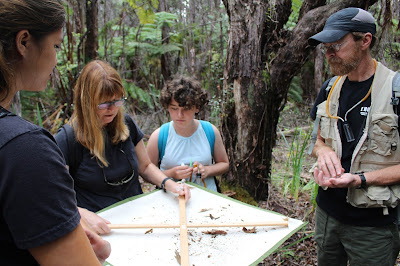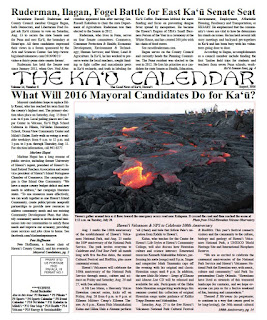HAWAI`I VOLCANOES NATIONAL PARK, with about half its 323,421 acres located in Ka`u, marked 100 years of history in August in tandem with the centennial of the National Park Service on Aug. 25.
Superintendent Cindy Orlando spoke on the National Public Radio program Here and Now in a feature entitled Flowing Lava at Hawai`i Volcanoes National Park. She said the park was established in 1916 to protect and conserve the volcanic landscapes and the natural and cultural resources and historic sites. Orlando described Hawai`i Volcanoes National Park as encompassing two of the world’s most active volcanoes, Kilauea and Mauna Loa. “It’s the only park in the system that continuously creates new land,” she said. |
| Visitors survey for insects during BioBlitz. Photo from NPS |
She pointed to the two eruptions ongoing on Kilauea, with one at 4,000 feet within Halema`uma`u Crater, with the dramatic glow at night, seen since 2008, and the lava lake, vibrant and visible from the overlook at Jaggar Museum. Kilauea has been continually erupting since 1983.
The newest eruption has sent lava, which can be seen 4,000 away, down on the coast. When traveling to the shore, she said, the view is inspired by dramatic lava fields that represent the birth of new land. On the way, the human story is evident at Pu`uloa Petroglyph Field where 23,000 carvings date back to between the 13th and 15th centuries.
Orlando provided some caution to visitors and urged them to be prepared and to check in with rangers before heading out on more than 150 miles of trails to hike. “Walking on hardened lava is not easy,” she said. She explained vog and the SO2 gases that sometimes require shutting down sections of the park. She noted that lava “is glass” carried in small particles in the air extending away from the volcano.
The newest eruption has sent lava, which can be seen 4,000 away, down on the coast. When traveling to the shore, she said, the view is inspired by dramatic lava fields that represent the birth of new land. On the way, the human story is evident at Pu`uloa Petroglyph Field where 23,000 carvings date back to between the 13th and 15th centuries.
Orlando provided some caution to visitors and urged them to be prepared and to check in with rangers before heading out on more than 150 miles of trails to hike. “Walking on hardened lava is not easy,” she said. She explained vog and the SO2 gases that sometimes require shutting down sections of the park. She noted that lava “is glass” carried in small particles in the air extending away from the volcano.
 |
| Two species of native carnivorous caterpillars that make their home at Hawai`i Volcanoes National Park. Photo from NPS |
Orlando reminded listeners that “the lava represents the birth of Pele. This is her sacred cultural landscape, and Pele is mesmerizing and beautiful, but she is also an active volcano, and there are associated hazards. You not only have seismic events. You have eruptions, the lava and volcanic gases. We can also have explosions.” She also talked about lava forming new land benches that can fall into the sea. Orlando said one of the challenges is visitor safety. “We are a model worldwide for providing safe access to lava viewing. Volcanoes are a natural wonder and many are drawn to them.”
Concerning plants and animal life, Orlando described the park as having an ecosystem that has evolved, adapted and flourishes on a volcanic landscape and that the park offers many educational and volunteer programs. “But let’s not forget that we also have a Hawaiian culture linked to Kilauea and Mauna Loa not only historically but today. Remember, this is the home of the volcano goddess Pele.”
Orlando said that three elements describe Hawai`i Volcanoes National Park: culture, biology and geology. Listen to the interview at http://www.wbur.org/hereandnow/2016/08/16/national-parks-hawaii.
 |
| Rick San Nicolas displays his featherwork through Aug. 31. |
THE 100TH ANNIVERSARY OF THE NATIONAL PARK SERVICE saw celebration by locals and visitors at the 36th annual Hawaiian Cultural Festival & BioBlitz. Held at Hawai`i Volcanoes National Park, the festival featured Hawaiian performers, including musician Kenneth Makuakane, the band Ho`onanea, and Aunty Diana Aki. Halau o Akaunu, Halau Ulumamo o Hilo Paliku and Haunani’s Hula Expressions danced hula, and more than a dozen cultural practitioners shared traditional Hawaiian culture, games and food.
A dozen firefighters from the National Park of American Samoa, on their way home from fighting fires on the mainland, delighted the crowd with a spontaneous haka and other traditional dances.
Artist-in-residence Rick San Nicolas, a master Hawaiian feather worker, hosted an open house at the park’s `Ohi`a Wing and presented the park with a beautiful lei kamoe in honor of its own centennial, which was Aug. 1. He will display his work through Aug. 31, from 10 a.m. to 3 p.m.
For the second year in a row, scientists and cultural experts, or alaka`i, conducted field inventories at locations around the summit of Kilauea, from rainforest to old lava flows. Families and individuals, intent on discovering the biodiversity in the park, documented 91 different species that included native creatures like the endemic carnivorous caterpillar, and non-native species like the Japanese white-eye, or mejiro, a small bird.
Families and visitors discovered how science and culture combine and visited the BioBlitz science and cultural booths at the festival. Representatives at the forefront of Rapid `Ohi`a Death, the `Alala Project, Mokupapapa Discovery Center and others shared conservation efforts to protect Hawai`i’s native species.
To read comments, add your own, and like this story, see Facebook. Follow us on Instagram and Twitter.
Artist-in-residence Rick San Nicolas, a master Hawaiian feather worker, hosted an open house at the park’s `Ohi`a Wing and presented the park with a beautiful lei kamoe in honor of its own centennial, which was Aug. 1. He will display his work through Aug. 31, from 10 a.m. to 3 p.m.
For the second year in a row, scientists and cultural experts, or alaka`i, conducted field inventories at locations around the summit of Kilauea, from rainforest to old lava flows. Families and individuals, intent on discovering the biodiversity in the park, documented 91 different species that included native creatures like the endemic carnivorous caterpillar, and non-native species like the Japanese white-eye, or mejiro, a small bird.
Families and visitors discovered how science and culture combine and visited the BioBlitz science and cultural booths at the festival. Representatives at the forefront of Rapid `Ohi`a Death, the `Alala Project, Mokupapapa Discovery Center and others shared conservation efforts to protect Hawai`i’s native species.
To read comments, add your own, and like this story, see Facebook. Follow us on Instagram and Twitter.
 |
| A tropical storm and a hurricane could impact Ka`u later this week. Map from University of Hawai`i |
TROPICAL STORM MADELINE is heading toward Ka`u. At 11a.m., the storm was 915 miles east of South Point. Central Pacific Hurricane Center’s latest forecast shows it reaching Ka`u Thursday evening. Madeline should curve toward the west, then slightly south of west with a slight increase in forward speed. Low vertical wind shear and warm sea surface temperatures are creating a small window for continued intensification into a hurricane during the next 24 to 36 hours. After than, guidance indicates that west to southwest vertical wind shear will increase, causing a return to tropical storm status.
“It is too early to determine what impacts Madeline could have on the Hawaiian Islands late in the forecast period,” according to CPHC. It is important to remind users that the average day four and five track forecast errors for central Pacific tropical cyclones is around 185 and 250 miles, respectively.” Not far behind Madeline is Hurricane Lester, also heading toward Hawai`i. According to National Hurricane Center, “given the well established steering flow, the track guidance continues to be tightly packed, and this increases the confidence in the future motion of the hurricane.”
To read comments, add your own, and like this story, see Facebook. Follow us on Instagram and Twitter.
To read comments, add your own, and like this story, see Facebook. Follow us on Instagram and Twitter.
 |
| Nani Soares and helper groom a horse at Punalu`u Livestock Ranch. Photo by Julia Neal |
 |
| Youngsters make friends with a baby goat at the ranch. Photo by Julia Neal |
Kyle Soares said this morning that the goats are managed, go out during the day and come home at night. He said they are like family and many have been bottle-fed. He said they are domestic, far from being wild goats that would run off into the rainforest and damage native habitat. “They are tame. We take care of them,” he said. “When it rains, they even take shelter in our garage.”
Soares said he has moved his cattle operation, to another location outside Ka`u, away from the ranch above Kawa, where he leases some 600 acres from Olson Trust and another 400 from the state. He said the lands just mauka of Kawa are a low-producing area for cattle, with lots of lava and often drought. It is appropriate land for goats, he said. “With several hundred, there is plenty of feed for them on the thousand acres.” Soares said that Ka`u is one of the top goat meat-producing areas on the island, with the biggest operator at Kapapala Ranch.
He said Punalu`u Livestock raises Boer goats, which are bred for meat. He said they originate in Africa and “are the most consumed red meat in the history of mankind.” He said goat meat is increasingly popular with chefs and is being sought by more people than ever before.
Conservationists stated that a wild herd of goats could make its way into native habitat, destroying endangered plants and habitat for endangered animals.
To read comments, add your own, and like this story, see Facebook. Follow us on Instagram and Twitter.
Conservationists stated that a wild herd of goats could make its way into native habitat, destroying endangered plants and habitat for endangered animals.
To read comments, add your own, and like this story, see Facebook. Follow us on Instagram and Twitter.
MEET KA`U’S U.S. REP. Tulsi Gabbard tomorrow. Gabbard hosts a Tulsi in Your Town meeting at Ka`u Coffee Mill from 1 p.m. to 3 p.m. She will meet Hawai`i Island constituents there to talk story, assist with federal casework and discuss legislative updates and priorities related to supporting local agriculture and farmers.
Gabbard will also discuss legislation she’s introduced to help control invasive species in Hawai`i and across the United States and her work to help secure green bean pricing valuation for Hawai`i-grown coffee, fight for truly transparent GMO-labeling, support the viability and success of local coffee farmers and producers, and more.
SUPPORT OUR SPONSORS AT PAHALAPLANTATIONCOTTAGES.COM AND KAUCOFFEEMILL.COM. KA`U COFFEE MILL IS OPEN SEVEN DAYS A WEEK.
 |
| Click on document to enlarge. |
 |
| See kaucalendar.com/KauCalendar_August_2016.pdf. |
 |
| See kaucalendar.com/TheDirectory2016.html and kaucalendar.com/TheDirectory2016.pdf. |



